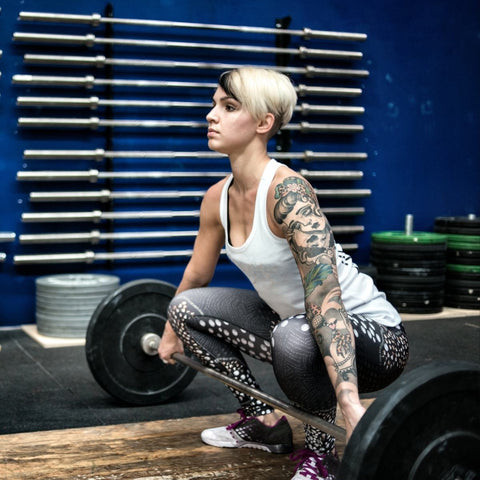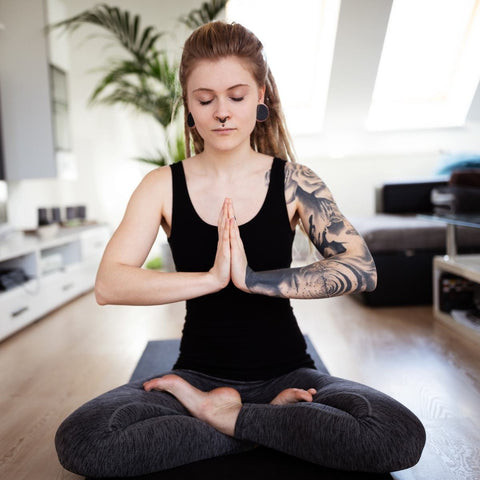Can You Workout The Day After A Tattoo? Absolutely! Getting a new tattoo doesn’t mean you have to ditch your fitness routine. At tattooat.com, we understand the importance of maintaining your active lifestyle while ensuring your new ink heals perfectly; it’s about finding the right balance between exercise and aftercare, so let’s dive in with everything you need to know about working out after getting tattooed. We’ll explore when and how to resume different workout activities, from cardio to weightlifting, while prioritizing your tattoo’s well-being.
1. Understanding Tattoo Aftercare and Exercise
The intersection of tattoo aftercare and exercise requires careful consideration. A new tattoo is essentially an open wound, making it vulnerable to infection and damage. Exercise, while beneficial for your overall health, can introduce challenges to the healing process.
1.1. The First 24-48 Hours: A Critical Period
The first 24-48 hours after getting a tattoo are crucial for initial healing. During this period, the tattoo is most susceptible to infection.
- What Happens: The skin is still open and raw, and the body’s natural healing processes are just beginning.
- What to Avoid: High-intensity workouts, excessive sweating, and direct contact with gym equipment.
1.2. Key Considerations for Exercising
Before resuming your workout routine, consider these key factors:
- Location of the Tattoo: Tattoos in high-friction areas (e.g., thighs, armpits) require extra care.
- Type of Exercise: High-impact activities and heavy lifting can stretch the skin and disrupt healing.
- Hygiene: Gym equipment can harbor bacteria, increasing the risk of infection.
2. General Guidelines for Working Out After a Tattoo
These general guidelines are paramount to ensuring that your tattoo heals properly while maintaining your workout regimen. Whether you’re into cardio, weightlifting, or yoga, these rules apply across the board.
2.1. Avoid Friction
Friction is a major enemy of a healing tattoo. When clothing or equipment rubs against the tattooed area, it can cause irritation, inflammation, and even damage to the fresh ink.
- Clothing: Wear loose-fitting clothing made of breathable fabrics like cotton. Avoid tight leggings, compression wear, or anything that clings to the skin.
- Equipment: Be mindful of how your body interacts with gym equipment. Use padding or barriers to minimize direct contact between the tattoo and benches, mats, or machines.
2.2. Keep it Clean
Maintaining impeccable hygiene is non-negotiable when exercising with a new tattoo. Sweat and bacteria can quickly turn a healing tattoo into a breeding ground for infection.
- Before and After: Always wash your hands thoroughly before touching your tattoo.
- During Workout: Gently pat the tattooed area with a clean, soft towel to absorb sweat. Avoid wiping or rubbing, which can cause irritation.
- Post-Workout: Shower immediately after exercising, using a mild, fragrance-free soap to cleanse the tattoo.
2.3. Minimize Stretching
Excessive stretching of the skin can disrupt the tattoo’s healing process, leading to distortion or scarring.
- Avoid Overextension: Be cautious with movements that excessively stretch the skin around the tattoo. Modify your range of motion as needed.
- Listen to Your Body: If you feel any pulling or discomfort in the tattooed area, stop the exercise immediately.
2.4. Stay Hydrated
Proper hydration is essential for overall skin health and can aid in the tattoo healing process.
- Drink Plenty of Water: Aim for at least eight glasses of water per day, and increase your intake when exercising.
- Hydration Benefits: Hydrated skin is more elastic and resilient, which can help prevent cracking and promote faster healing.
2.5. Follow Tattoo Aftercare Instructions
Adhering to your tattoo artist’s aftercare instructions is crucial. These guidelines are tailored to your specific tattoo and skin type.
- Cleansing: Gently wash the tattoo with mild soap and water 2-3 times a day.
- Moisturizing: Apply a thin layer of fragrance-free, hypoallergenic moisturizer to keep the skin hydrated.
- Avoid Sun Exposure: Protect your tattoo from direct sunlight by wearing loose clothing or using a tattoo-safe sunscreen.
3. Specific Workout Activities and Tattoo Aftercare
Different workout activities pose unique challenges to a healing tattoo. Understanding these challenges and how to mitigate them is essential for a smooth recovery.
3.1. Cardio
Cardio workouts, such as running, cycling, and swimming, can increase blood flow and body temperature, potentially affecting the tattoo.
- Running and Cycling:
- Challenge: Friction from clothing and equipment (e.g., shoes rubbing against an ankle tattoo).
- Solution: Wear loose-fitting clothing and use padding or bandages to protect the tattoo.
- Swimming:
- Challenge: Exposure to bacteria and chemicals in pools, lakes, and oceans.
- Solution: Avoid swimming until the tattoo is fully healed (usually 2-4 weeks). Use waterproof bandages if swimming is unavoidable.
 Swimming After Tattoo
Swimming After Tattoo
3.2. High-Intensity Interval Training (HIIT)
HIIT workouts involve intense bursts of activity followed by short recovery periods, which can lead to excessive sweating and friction.
- Challenge: Increased sweat production and potential for chafing.
- Solution: Wear breathable clothing, use moisture-wicking fabrics, and apply a thin layer of barrier cream (e.g., Aquaphor) to protect the tattoo.
3.3. CrossFit
CrossFit combines weightlifting, cardio, and gymnastic movements, posing multiple challenges to a healing tattoo.
- Challenge: High-impact movements, friction from equipment, and exposure to shared surfaces.
- Solution: Modify exercises to avoid direct contact with the tattoo, use personal equipment when possible, and thoroughly clean shared equipment before and after use.
 CrossFit Workouts After Tattoo
CrossFit Workouts After Tattoo
3.4. Weightlifting and Bodybuilding
Weightlifting and bodybuilding can cause significant stretching and friction, especially if the tattoo is located on a muscle group being worked.
- Challenge: Stretching of the skin, friction from clothing and equipment, and potential for injury.
- Solution: Reduce the weight and range of motion, use padding or wraps to protect the tattoo, and avoid exercises that directly stress the tattooed area.
3.5. Yoga and Stretching
Yoga and stretching can be beneficial for flexibility and relaxation, but certain poses can put stress on a healing tattoo.
- Challenge: Overstretching of the skin and friction from mats and clothing.
- Solution: Modify poses to avoid stretching the tattooed area, use a clean yoga mat, and wear loose-fitting clothing.
 Yoga and Stretching Workouts After Tattoo
Yoga and Stretching Workouts After Tattoo
3.6. Sports-Specific Workouts
Sports-specific workouts can vary widely in intensity and impact, requiring tailored precautions.
- Challenge: Contact with equipment, other players, and the environment.
- Solution: Wear protective gear, avoid direct contact with the tattoo, and follow all hygiene guidelines.
4. Expert Tips for a Smooth Recovery
To ensure your tattoo heals beautifully while you stay active, follow these expert tips.
4.1. Consult Your Tattoo Artist
Your tattoo artist is your best resource for personalized advice.
- Ask Specific Questions: Discuss your workout routine with your artist and ask for specific recommendations based on the tattoo’s location and size.
- Follow Their Instructions: Adhere to their aftercare guidelines, as they are tailored to your skin type and the tattoo’s design.
4.2. Monitor Your Tattoo Closely
Pay close attention to your tattoo’s appearance and any changes that may occur.
- Watch for Signs of Infection: Redness, swelling, pus, and excessive pain are all signs of infection. Seek medical attention immediately if you notice any of these symptoms.
- Observe Healing Progress: Track how your tattoo is healing over time. If you notice any delays or abnormalities, consult your tattoo artist or a healthcare professional.
4.3. Adjust Your Workout Schedule
Be willing to modify your workout schedule to accommodate your healing tattoo.
- Reduce Intensity: Lower the intensity of your workouts to minimize sweating and friction.
- Shorten Duration: Limit the duration of your workouts to prevent overexertion and potential complications.
4.4. Protect Your Tattoo from the Sun
Sun exposure can cause fading and damage to a new tattoo.
- Cover Up: Wear loose-fitting clothing to shield your tattoo from direct sunlight.
- Use Sunscreen: Apply a tattoo-safe sunscreen with an SPF of 30 or higher to any exposed areas.
4.5. Stay Patient
Healing a tattoo takes time, and rushing the process can lead to complications.
- Allow Adequate Rest: Give your body the rest it needs to recover and heal.
- Avoid Overdoing It: Don’t push yourself too hard, and listen to your body’s signals.
5. Addressing Common Concerns
It’s natural to have questions and concerns about working out after getting a tattoo. Let’s address some of the most common ones.
5.1. Can Sweat Ruin My New Tattoo?
Sweat itself won’t ruin your tattoo, but it can create an environment conducive to bacterial growth.
- Keep It Clean: Gently pat the tattooed area with a clean towel during workouts.
- Shower Promptly: Shower immediately after exercising to remove sweat and bacteria.
5.2. What If My Tattoo Rubs Against My Clothing?
Friction can irritate the tattoo and disrupt the healing process.
- Loose Clothing: Wear loose-fitting clothing made of breathable fabrics.
- Padding: Use padding or bandages to protect the tattoo from direct contact.
5.3. Can I Use a Sauna or Steam Room?
Saunas and steam rooms can increase sweating and expose the tattoo to bacteria.
- Avoid Until Healed: It’s best to avoid saunas and steam rooms until the tattoo is fully healed.
5.4. What If I Get My Tattoo Wet?
Getting your tattoo wet isn’t necessarily harmful, but prolonged exposure can increase the risk of infection.
- Gently Pat Dry: If your tattoo gets wet, gently pat it dry with a clean towel.
- Avoid Soaking: Avoid soaking the tattoo in water for extended periods.
5.5. When Can I Start Using Lotion on My Tattoo?
You can start using lotion on your tattoo once the initial healing phase is over (usually after a few days).
- Fragrance-Free: Choose a fragrance-free, hypoallergenic lotion.
- Thin Layer: Apply a thin layer of lotion to keep the skin hydrated.
6. Real-Life Examples and Case Studies
To illustrate how these guidelines work in practice, let’s look at some real-life examples and case studies.
6.1. Case Study 1: The Marathon Runner
A marathon runner gets a tattoo on their calf and wants to resume training as soon as possible.
- Precautions: Wears loose-fitting shorts, uses a bandage to protect the tattoo from rubbing against their socks, and applies a thin layer of barrier cream before each run.
- Outcome: Successfully resumes training without any complications, and the tattoo heals beautifully.
6.2. Case Study 2: The Weightlifter
A weightlifter gets a tattoo on their chest and is eager to get back to the gym.
- Precautions: Reduces the weight and range of motion, uses padding on the bench press, and avoids exercises that directly stress the tattooed area.
- Outcome: Successfully maintains their strength and fitness levels without damaging the tattoo.
6.3. Case Study 3: The Yoga Enthusiast
A yoga enthusiast gets a tattoo on their back and wants to continue practicing.
- Precautions: Modifies poses to avoid stretching the tattooed area, uses a clean yoga mat, and wears loose-fitting clothing.
- Outcome: Enjoys their yoga practice without any discomfort or complications.
7. The Importance of Choosing the Right Tattoo Artist
Selecting a skilled and reputable tattoo artist is crucial for a successful outcome.
7.1. Research and Reviews
Read online reviews and ask for recommendations from friends and family.
7.2. Portfolio
Review the artist’s portfolio to ensure their style matches your preferences.
7.3. Cleanliness and Hygiene
Choose a studio that follows strict hygiene protocols and uses sterile equipment.
7.4. Communication
Communicate your concerns and expectations with the artist before getting tattooed.
8. Long-Term Tattoo Care
Once your tattoo is fully healed, it’s essential to continue caring for it to maintain its appearance.
8.1. Sun Protection
Protect your tattoo from direct sunlight by wearing loose clothing or using a tattoo-safe sunscreen.
8.2. Moisturizing
Keep your skin hydrated by applying lotion regularly.
8.3. Avoid Harsh Chemicals
Avoid using harsh chemicals or abrasive cleansers on your tattoo.
8.4. Stay Healthy
A healthy lifestyle can contribute to the overall appearance and longevity of your tattoo.
9. Finding Inspiration and Artists at tattooat.com
Looking for tattoo inspiration or the perfect artist? tattooat.com is your ultimate resource!
9.1. Extensive Design Gallery
Browse thousands of tattoo designs in various styles and themes.
9.2. Artist Directory
Find talented tattoo artists near you, complete with portfolios and contact information.
9.3. Informative Articles
Read articles on tattoo aftercare, trends, and history to stay informed and inspired.
10. Frequently Asked Questions (FAQs) About Working Out After a Tattoo
Still have questions? Here are some frequently asked questions about working out after getting a tattoo.
- Is it okay to workout the day after getting a tattoo?
Yes, but with precautions. Avoid friction, keep it clean, and minimize stretching. - How long should I wait to swim after getting a tattoo?
Wait until the tattoo is fully healed, usually 2-4 weeks. - Can sweat ruin my new tattoo?
Sweat itself won’t ruin the tattoo, but it can create an environment conducive to bacterial growth. Keep the area clean. - What kind of clothing should I wear while working out with a new tattoo?
Wear loose-fitting clothing made of breathable fabrics like cotton. - Can I use a sauna or steam room after getting a tattoo?
It’s best to avoid saunas and steam rooms until the tattoo is fully healed. - When can I start using lotion on my tattoo?
You can start using lotion once the initial healing phase is over, usually after a few days. - What are the signs of a tattoo infection?
Redness, swelling, pus, and excessive pain. Seek medical attention immediately if you notice any of these symptoms. - How can I protect my tattoo from the sun?
Wear loose-fitting clothing or use a tattoo-safe sunscreen with an SPF of 30 or higher. - Can I still do yoga after getting a tattoo?
Yes, but modify poses to avoid stretching the tattooed area and use a clean yoga mat. - Where can I find inspiration and artists for my next tattoo?
Visit tattooat.com to browse designs and find talented artists near you.
Getting a new tattoo doesn’t mean putting your fitness goals on hold. By following these guidelines and listening to your body, you can maintain your workout routine while ensuring your tattoo heals beautifully. Remember to consult your tattoo artist for personalized advice and visit tattooat.com for inspiration and resources. Ready to find the perfect design or artist? Explore tattooat.com today and discover the world of tattoo art! Contact us at Address: 1825 SW Broadway, Portland, OR 97201, United States or Phone: +1 (503) 725-3000.